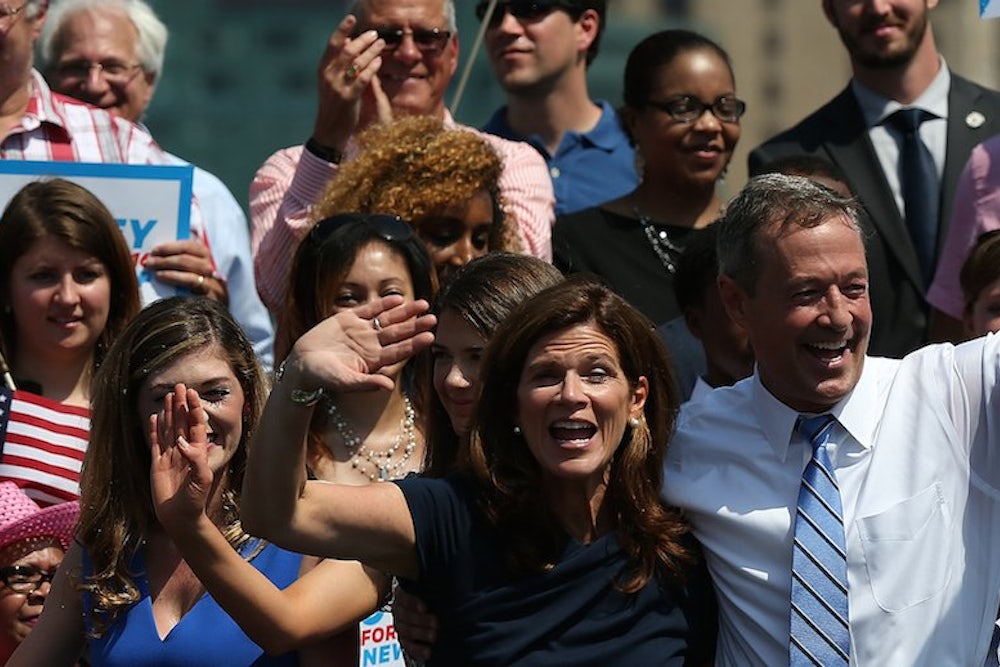Presidential candidate Martin O’Malley is polling a distant third among declared Democrats, ten points behind Vermont Senator Bernie Sanders and more than 60 points behind Hillary Clinton. Closing that gap in any significant way will require taking stronger positions than his rivals on the issues most important to the party’s base. He’s done just that with his aggressive new plan on climate change, which the former Maryland governor will pitch to Iowans over the next three days.
Unveiled last week in an op-ed for USA Today, the plan calls for the U.S. to move entirely to clean energy within 35 years. It also aims to double energy efficiency in the next 15 years, create a Clean Energy Jobs Corps to retrofit buildings, modernize the energy grid, end fossil fuel subsidies, and extend tax credits for solar and wind power. Some of these are policies already championed by Obama, but O’Malley still goes further, by wanting to adopt a “zero-tolerance policy” for methane from natural gas production and to expand carbon regulation to other major sources (presumably meaning agriculture and industry, which account for 9 and 21 percent of domestic emissions, respectively); and he says he’d deny new permits for offshore drilling and in Alaska.
O’Malley rightly sees an opportunity here to peel off supporters from his rivals.
Environmentalists remain unconvinced by Clinton, whose climate agenda is fuzzy. She has yet to take a stand on the Keystone XL pipeline, and recently hired a campaign consultant who previously lobbied the State Department—while Clinton was secretary of state—on behalf of TransCanada, the company behind the pipeline.
Sanders, meanwhile, has been the candidate of choice for Clinton’s enivoronmental skeptics. He’s a longtime favorite of the green movement, having co-sponsored carbon tax legislation and bills to expand residential solar energy. He has a lifetime score of 95 percent from the League of Conservation Voters, and Climate Hawks Vote ranks him as the top Senator on climate.
But environmental campaigners are starting to notice O’Malley now.
“We look to presidential policy platforms for vision, and we’re rapidly approaching, if not already at, a point where it’s no longer enough for a Democratic candidate to diagnose the problem,” Climate Hawks Vote founder R.L. Miller said. “[W]e need policy prescriptions. Sanders’ platform is basically what he’s been pushing, without success, in the Senate—a carbon tax and a million solar rooftops.”
In other words: Namechecking Keystone and making fun of climate-change deniers doesn’t cut it anymore.
Environmentalists’ general restlessness and demands for specific proposals reflect the movement’s increasing electoral influence. Since the last presidential cycle, green organizers have succeeded in further delaying the Keystone XL pipeline and have powerful new allies like Democratic billionaire Tom Steyer, Pope Francis, and even a new Republican megadonor.
Steyer, who has praised Clinton in the past, now hails O’Malley’s climate leadership.
“Governor O’Malley is presenting real, concrete solutions to climate change that will secure our country’s economic security—and break with the dirty energy politics of the past,” he said last week.
Asked to compare O’Malley and Sanders, a spokesperson for Steyer’s campaign arm, NextGen Climate Action, made clear that the group would like Clinton and Sanders to accept O’Malley’s challenge.
“Martin O’Malley has already outlined a bold plan to create a clean energy economy and Bernie Sanders and Hillary Clinton have strong records of embracing climate action—and in the coming weeks and months we look forward to hearing their detailed plans to build a clean energy future for our country,” spokersperson Suzanne Henkels said.
Sanders’s website lists climate as one of his core issues, but gives little detail beyond pointing to the senator’s past votes, like introducing the “the gold standard for climate change legislation with Sen. Barbara Boxer to tax carbon and methane emissions,” opposing Keystone XL pipeline, and securing stimulus funds for retrofitting buildings and boosting solar. Clinton’s site outlines four key fights—creating a fairer economy, strengthening communities, working families, protecting national security, and fixing political dysfunction. Climate change and clean energy earn a mention under her plans for the economy, yet she has yet to elaborate on specific policies beyond endorsing the renewable fuel standard.
Granted, some of O’Malley’s ideas overlap with ones pushed already by President Barack Obama. And the centerpiece of O’Malley’s proposal—reaching 100 percent renewables by 2050—is hardly realistic, as it would require action from a split Congress. According to a recent paper by Stanford researcher Mark Jacobson, 100 percent renewable means completely electrifying everything from transportation to heating homes, and then building a radical new number of plants powered by wind, water, and solar. The study notes the country would need 328,000 new onshore wind turbines, 156,200 off-shore turbines, and 46,480 utility-scale solar power plants to meet average demand alone.
In Jacobson’s vision for going entirely renewable, rooftop solar accounts for just four percent of electricity demand. Sanders’s big pitch to voters is a bill he’s sponsored since 2010 to provide rebates for installing ten million rooftop solar systems. He introduced it again in January as an amendment to a pro-Keystone XL bill, but it failed 40-58.
